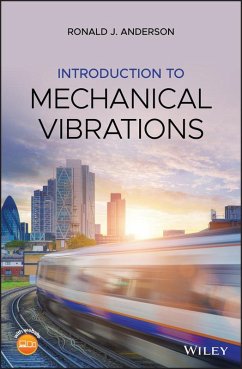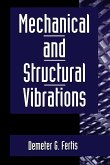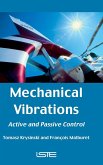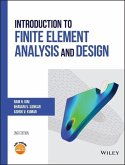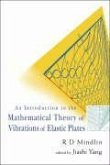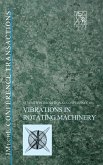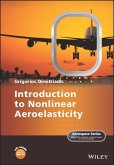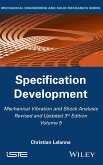Ronald J Anderson
Introduction to Mechanical Vibrations
Ronald J Anderson
Introduction to Mechanical Vibrations
- Gebundenes Buch
Andere Kunden interessierten sich auch für
![Mechanical and Structural Vibrations Mechanical and Structural Vibrations]() Demeter G FertisMechanical and Structural Vibrations264,99 €
Demeter G FertisMechanical and Structural Vibrations264,99 €![Mechanical Vibrations Mechanical Vibrations]() Tomasz KrysinskiMechanical Vibrations281,99 €
Tomasz KrysinskiMechanical Vibrations281,99 €![Introduction to Finite Element Analysis and Design Introduction to Finite Element Analysis and Design]() Nam-Ho KimIntroduction to Finite Element Analysis and Design146,99 €
Nam-Ho KimIntroduction to Finite Element Analysis and Design146,99 €![An Introduction to the Mathematical Theory of Vibrations of Elastic Plates An Introduction to the Mathematical Theory of Vibrations of Elastic Plates]() Jiashi YangAn Introduction to the Mathematical Theory of Vibrations of Elastic Plates97,99 €
Jiashi YangAn Introduction to the Mathematical Theory of Vibrations of Elastic Plates97,99 €![Vibrations in Rotating Machinery Vibrations in Rotating Machinery]() Pep (Professional Engineering Publishers)Vibrations in Rotating Machinery585,99 €
Pep (Professional Engineering Publishers)Vibrations in Rotating Machinery585,99 €![Introduction to Nonlinear Aeroelasticity Introduction to Nonlinear Aeroelasticity]() Grigorios DimitriadisIntroduction to Nonlinear Aeroelasticity160,99 €
Grigorios DimitriadisIntroduction to Nonlinear Aeroelasticity160,99 €![Mechanical Vibration and Shock Analysis, Specification Development Mechanical Vibration and Shock Analysis, Specification Development]() Christian LalanneMechanical Vibration and Shock Analysis, Specification Development253,99 €
Christian LalanneMechanical Vibration and Shock Analysis, Specification Development253,99 €-
-
-
Produktdetails
- Verlag: Wiley
- Seitenzahl: 288
- Erscheinungstermin: 8. Juni 2020
- Englisch
- Abmessung: 246mm x 170mm x 23mm
- Gewicht: 676g
- ISBN-13: 9781119053651
- ISBN-10: 111905365X
- Artikelnr.: 58602509
Hinweis: Dieser Artikel kann nur an eine deutsche Lieferadresse ausgeliefert werden.
- Herstellerkennzeichnung
- Libri GmbH
- Europaallee 1
- 36244 Bad Hersfeld
- gpsr@libri.de
DR. RONALD J. ANDERSON is a Professor in the Department of Mechanical and Materials Engineering, Queen's University at Kingston, Canada. He received his B.Sc.(Eng) from the University of Alberta in 1973, his M.Sc.(Eng) from Queen's University in 1974, and his Ph.D. from Queen's University in 1977. His doctoral research was in the field of road vehicle dynamics. From 1977 to 1979, he was a Defence Scientist with the Defence Research Establishment Atlantic where he was engaged in research on the dynamics of novel ships. From 1979 to 1981 he was Senior Dynamicist with the Urban Transportation Development Corporation where he worked on rail vehicle dynamics, particularly suspension design for steerable rail vehicles. He joined Queen's University in 1981 and, while conducting research into vehicle dynamics and multibody dynamics, has been teaching undergraduate courses on dynamics and vibrations and postgraduate courses on advanced dynamics and engineering analysis. Dr. Anderson has been the recipient of several departmental and faculty-wide teaching awards. He has also served the University in the academic administrative roles of Head of Department, Associate Dean (Research), and Dean of Graduate Studies.
Preface xi
About the Companion Website xv
1 The Transition from Dynamics to Vibrations 1
1.1 Bead on a Wire: The Nonlinear Equations of Motion 2
1.1.1 Formal Vector Approach using Newton's Laws 3
1.1.2 Informal Vector Approach using Newton's Laws 5
1.1.3 Lagrange's Equations of Motion 6
1.1.3.1 The Bead on a Wire via Lagrange's Equations 7
1.1.3.2 Generalized Coordinates 9
1.1.3.3 Generalized Forces 9
1.1.3.4 Dampers - Rayleigh's Dissipation Function 11
1.2 Equilibrium Solutions 12
1.2.1 Equilibrium of a Simple Pendulum 12
1.2.2 Equilibrium of the Bead on the Wire 13
1.3 Linearization 14
1.3.1 Geometric Nonlinearities 14
1.3.1.1 Linear EOM for a Simple Pendulum 15
1.3.1.2 Linear EOM for the Bead on the Wire 17
1.3.2 Nonlinear Structural Elements 18
1.4 Summary 19
Exercises 19
2 Single Degree of Freedom Systems - Modeling 23
2.1 Modeling Single Degree of Freedom Systems 23
2.1.1 Deriving the Equation of Motion 24
2.1.2 Equations of Motion Ignoring Preloads 27
2.1.3 Finding Spring Deflections due to Body Rotations 29
Exercises 34
3 Single Degree of Freedom Systems - Free Vibrations 39
3.1 Undamped Free Vibrations 39
3.2 Response to Initial Conditions 41
3.3 Damped Free Vibrations 44
3.3.1 Standard Form for Second-Order Systems 46
3.3.2 Undamped 47
3.3.3 Underdamped 48
3.3.4 Critically Damped 50
3.3.5 Overdamped 51
3.4 Root Locus 52
Exercises 53
4 SDOF Systems - Forced Vibrations - Response to Initial Conditions 59
4.1 Time Response to a Harmonically Applied Force in Undamped Systems 59
4.1.1 Beating 61
4.1.2 Resonance 63
Exercises 65
5 SDOF Systems - Steady State Forced Vibrations 67
5.1 Undamped Steady State Response to a Harmonically Applied Force 67
5.2 Damped Steady State Response to a Harmonically Applied Force 70
5.3 Response to Harmonic Base Motion 73
5.4 Response to a Rotating Unbalance 77
5.5 Accelerometers 82
Exercises 85
6 Damping 89
6.1 Linear Viscous Damping 89
6.2 Coulomb or Dry Friction Damping 93
6.3 Logarithmic Decrement 96
Exercises 97
7 Systems with More than One Degree of Freedom 101
7.1 2DOF Undamped Free Vibrations - Modeling 101
7.2 2DOF Undamped Free Vibrations - Natural Frequencies 104
7.3 2DOF Undamped Free Vibrations - Mode Shapes 106
7.3.1 An Example 107
7.4 Mode Shape Descriptions 110
7.5 Response to Initial Conditions 112
7.6 2DOF Undamped Forced Vibrations 115
7.7 Vibration Absorbers 116
7.8 The Method of Normal Modes 118
7.9 The Cart and Pendulum Example 123
7.9.1 Modeling the System - Two Ways 124
7.9.1.1 Kinematics 124
7.9.1.2 Newton's Laws 125
7.9.1.3 Lagrange's Equation 127
7.10 Normal Modes Example 129
Exercises 132
8 Continuous Systems 137
8.1 The Equations of Motion for a Taut String 137
8.2 Natural Frequencies and Mode Shapes for a Taut String 139
8.3 Vibrations of Uniform Beams 142
Exercises 151
9 Finite Elements 153
9.1 Shape Functions 153
9.2 The Stiffness Matrix for an Elastic Rod 155
9.3 The Mass Matrix for an Elastic Rod 161
9.4 Using Multiple Elements 164
9.5 The Two-noded Beam Element 167
9.5.1 The Two-noded Beam Element - Stiffness Matrix 168
9.5.2 The Two-noded Beam Element - Mass Matrix 171
9.6 Two-noded Beam Element Vibrations Example 173
Exercises 177
10 The Inerter 181
10.1 Modeling the Inerter 181
10.2 The Inerter in the Equations of Motion 184
10.3 An Examination of the Effect of an Inerter on System Response 186
10.3.1 The Baseline Case - p = 0 187
10.3.2 The Case Where the Inerter Adds Mass Equal to the Block's Mass - p
= 1 188
10.3.3 The Case Where p is Very Large 188
10.4 The Inerter as a Vibration Absorber 190
Exercises 193
11 Analysis of Experimental Data 195
11.1 Typical Test Data 195
11.2 Transforming to the Frequency Domain - The CFT 197
11.3 Transforming to the Frequency Domain - The DFT 200
11.4 Transforming to the Frequency Domain - A Faster DFT 202
11.5 Transforming to the Frequency Domain - The FFT 203
11.6 Transforming to the Frequency Domain - An Example 204
11.7 Sampling and Aliasing 207
11.8 Leakage and Windowing 212
11.9 Decimating Data 216
11.10 Averaging FFTs 225
Exercises 228
12 Topics in Vibrations 231
12.1 What About the Mass of the Spring? 231
12.2 Flow-induced Vibrations 233
12.3 Self-Excited Oscillations of Railway Wheelsets 238
12.4 What is a Rigid Body Mode? 249
12.5 Why Static Deflection is Very Useful 251
Exercises 254
Appendix A: Least Squares Curve Fitting 257
Appendix B: Moments of Inertia 261
B.1 Parallel Axis Theorem for Moments of Inertia 262
B.2 Moments of Inertia for Commonly Encountered Bodies 263
Index 265
About the Companion Website xv
1 The Transition from Dynamics to Vibrations 1
1.1 Bead on a Wire: The Nonlinear Equations of Motion 2
1.1.1 Formal Vector Approach using Newton's Laws 3
1.1.2 Informal Vector Approach using Newton's Laws 5
1.1.3 Lagrange's Equations of Motion 6
1.1.3.1 The Bead on a Wire via Lagrange's Equations 7
1.1.3.2 Generalized Coordinates 9
1.1.3.3 Generalized Forces 9
1.1.3.4 Dampers - Rayleigh's Dissipation Function 11
1.2 Equilibrium Solutions 12
1.2.1 Equilibrium of a Simple Pendulum 12
1.2.2 Equilibrium of the Bead on the Wire 13
1.3 Linearization 14
1.3.1 Geometric Nonlinearities 14
1.3.1.1 Linear EOM for a Simple Pendulum 15
1.3.1.2 Linear EOM for the Bead on the Wire 17
1.3.2 Nonlinear Structural Elements 18
1.4 Summary 19
Exercises 19
2 Single Degree of Freedom Systems - Modeling 23
2.1 Modeling Single Degree of Freedom Systems 23
2.1.1 Deriving the Equation of Motion 24
2.1.2 Equations of Motion Ignoring Preloads 27
2.1.3 Finding Spring Deflections due to Body Rotations 29
Exercises 34
3 Single Degree of Freedom Systems - Free Vibrations 39
3.1 Undamped Free Vibrations 39
3.2 Response to Initial Conditions 41
3.3 Damped Free Vibrations 44
3.3.1 Standard Form for Second-Order Systems 46
3.3.2 Undamped 47
3.3.3 Underdamped 48
3.3.4 Critically Damped 50
3.3.5 Overdamped 51
3.4 Root Locus 52
Exercises 53
4 SDOF Systems - Forced Vibrations - Response to Initial Conditions 59
4.1 Time Response to a Harmonically Applied Force in Undamped Systems 59
4.1.1 Beating 61
4.1.2 Resonance 63
Exercises 65
5 SDOF Systems - Steady State Forced Vibrations 67
5.1 Undamped Steady State Response to a Harmonically Applied Force 67
5.2 Damped Steady State Response to a Harmonically Applied Force 70
5.3 Response to Harmonic Base Motion 73
5.4 Response to a Rotating Unbalance 77
5.5 Accelerometers 82
Exercises 85
6 Damping 89
6.1 Linear Viscous Damping 89
6.2 Coulomb or Dry Friction Damping 93
6.3 Logarithmic Decrement 96
Exercises 97
7 Systems with More than One Degree of Freedom 101
7.1 2DOF Undamped Free Vibrations - Modeling 101
7.2 2DOF Undamped Free Vibrations - Natural Frequencies 104
7.3 2DOF Undamped Free Vibrations - Mode Shapes 106
7.3.1 An Example 107
7.4 Mode Shape Descriptions 110
7.5 Response to Initial Conditions 112
7.6 2DOF Undamped Forced Vibrations 115
7.7 Vibration Absorbers 116
7.8 The Method of Normal Modes 118
7.9 The Cart and Pendulum Example 123
7.9.1 Modeling the System - Two Ways 124
7.9.1.1 Kinematics 124
7.9.1.2 Newton's Laws 125
7.9.1.3 Lagrange's Equation 127
7.10 Normal Modes Example 129
Exercises 132
8 Continuous Systems 137
8.1 The Equations of Motion for a Taut String 137
8.2 Natural Frequencies and Mode Shapes for a Taut String 139
8.3 Vibrations of Uniform Beams 142
Exercises 151
9 Finite Elements 153
9.1 Shape Functions 153
9.2 The Stiffness Matrix for an Elastic Rod 155
9.3 The Mass Matrix for an Elastic Rod 161
9.4 Using Multiple Elements 164
9.5 The Two-noded Beam Element 167
9.5.1 The Two-noded Beam Element - Stiffness Matrix 168
9.5.2 The Two-noded Beam Element - Mass Matrix 171
9.6 Two-noded Beam Element Vibrations Example 173
Exercises 177
10 The Inerter 181
10.1 Modeling the Inerter 181
10.2 The Inerter in the Equations of Motion 184
10.3 An Examination of the Effect of an Inerter on System Response 186
10.3.1 The Baseline Case - p = 0 187
10.3.2 The Case Where the Inerter Adds Mass Equal to the Block's Mass - p
= 1 188
10.3.3 The Case Where p is Very Large 188
10.4 The Inerter as a Vibration Absorber 190
Exercises 193
11 Analysis of Experimental Data 195
11.1 Typical Test Data 195
11.2 Transforming to the Frequency Domain - The CFT 197
11.3 Transforming to the Frequency Domain - The DFT 200
11.4 Transforming to the Frequency Domain - A Faster DFT 202
11.5 Transforming to the Frequency Domain - The FFT 203
11.6 Transforming to the Frequency Domain - An Example 204
11.7 Sampling and Aliasing 207
11.8 Leakage and Windowing 212
11.9 Decimating Data 216
11.10 Averaging FFTs 225
Exercises 228
12 Topics in Vibrations 231
12.1 What About the Mass of the Spring? 231
12.2 Flow-induced Vibrations 233
12.3 Self-Excited Oscillations of Railway Wheelsets 238
12.4 What is a Rigid Body Mode? 249
12.5 Why Static Deflection is Very Useful 251
Exercises 254
Appendix A: Least Squares Curve Fitting 257
Appendix B: Moments of Inertia 261
B.1 Parallel Axis Theorem for Moments of Inertia 262
B.2 Moments of Inertia for Commonly Encountered Bodies 263
Index 265
Preface xi
About the Companion Website xv
1 The Transition from Dynamics to Vibrations 1
1.1 Bead on a Wire: The Nonlinear Equations of Motion 2
1.1.1 Formal Vector Approach using Newton's Laws 3
1.1.2 Informal Vector Approach using Newton's Laws 5
1.1.3 Lagrange's Equations of Motion 6
1.1.3.1 The Bead on a Wire via Lagrange's Equations 7
1.1.3.2 Generalized Coordinates 9
1.1.3.3 Generalized Forces 9
1.1.3.4 Dampers - Rayleigh's Dissipation Function 11
1.2 Equilibrium Solutions 12
1.2.1 Equilibrium of a Simple Pendulum 12
1.2.2 Equilibrium of the Bead on the Wire 13
1.3 Linearization 14
1.3.1 Geometric Nonlinearities 14
1.3.1.1 Linear EOM for a Simple Pendulum 15
1.3.1.2 Linear EOM for the Bead on the Wire 17
1.3.2 Nonlinear Structural Elements 18
1.4 Summary 19
Exercises 19
2 Single Degree of Freedom Systems - Modeling 23
2.1 Modeling Single Degree of Freedom Systems 23
2.1.1 Deriving the Equation of Motion 24
2.1.2 Equations of Motion Ignoring Preloads 27
2.1.3 Finding Spring Deflections due to Body Rotations 29
Exercises 34
3 Single Degree of Freedom Systems - Free Vibrations 39
3.1 Undamped Free Vibrations 39
3.2 Response to Initial Conditions 41
3.3 Damped Free Vibrations 44
3.3.1 Standard Form for Second-Order Systems 46
3.3.2 Undamped 47
3.3.3 Underdamped 48
3.3.4 Critically Damped 50
3.3.5 Overdamped 51
3.4 Root Locus 52
Exercises 53
4 SDOF Systems - Forced Vibrations - Response to Initial Conditions 59
4.1 Time Response to a Harmonically Applied Force in Undamped Systems 59
4.1.1 Beating 61
4.1.2 Resonance 63
Exercises 65
5 SDOF Systems - Steady State Forced Vibrations 67
5.1 Undamped Steady State Response to a Harmonically Applied Force 67
5.2 Damped Steady State Response to a Harmonically Applied Force 70
5.3 Response to Harmonic Base Motion 73
5.4 Response to a Rotating Unbalance 77
5.5 Accelerometers 82
Exercises 85
6 Damping 89
6.1 Linear Viscous Damping 89
6.2 Coulomb or Dry Friction Damping 93
6.3 Logarithmic Decrement 96
Exercises 97
7 Systems with More than One Degree of Freedom 101
7.1 2DOF Undamped Free Vibrations - Modeling 101
7.2 2DOF Undamped Free Vibrations - Natural Frequencies 104
7.3 2DOF Undamped Free Vibrations - Mode Shapes 106
7.3.1 An Example 107
7.4 Mode Shape Descriptions 110
7.5 Response to Initial Conditions 112
7.6 2DOF Undamped Forced Vibrations 115
7.7 Vibration Absorbers 116
7.8 The Method of Normal Modes 118
7.9 The Cart and Pendulum Example 123
7.9.1 Modeling the System - Two Ways 124
7.9.1.1 Kinematics 124
7.9.1.2 Newton's Laws 125
7.9.1.3 Lagrange's Equation 127
7.10 Normal Modes Example 129
Exercises 132
8 Continuous Systems 137
8.1 The Equations of Motion for a Taut String 137
8.2 Natural Frequencies and Mode Shapes for a Taut String 139
8.3 Vibrations of Uniform Beams 142
Exercises 151
9 Finite Elements 153
9.1 Shape Functions 153
9.2 The Stiffness Matrix for an Elastic Rod 155
9.3 The Mass Matrix for an Elastic Rod 161
9.4 Using Multiple Elements 164
9.5 The Two-noded Beam Element 167
9.5.1 The Two-noded Beam Element - Stiffness Matrix 168
9.5.2 The Two-noded Beam Element - Mass Matrix 171
9.6 Two-noded Beam Element Vibrations Example 173
Exercises 177
10 The Inerter 181
10.1 Modeling the Inerter 181
10.2 The Inerter in the Equations of Motion 184
10.3 An Examination of the Effect of an Inerter on System Response 186
10.3.1 The Baseline Case - p = 0 187
10.3.2 The Case Where the Inerter Adds Mass Equal to the Block's Mass - p
= 1 188
10.3.3 The Case Where p is Very Large 188
10.4 The Inerter as a Vibration Absorber 190
Exercises 193
11 Analysis of Experimental Data 195
11.1 Typical Test Data 195
11.2 Transforming to the Frequency Domain - The CFT 197
11.3 Transforming to the Frequency Domain - The DFT 200
11.4 Transforming to the Frequency Domain - A Faster DFT 202
11.5 Transforming to the Frequency Domain - The FFT 203
11.6 Transforming to the Frequency Domain - An Example 204
11.7 Sampling and Aliasing 207
11.8 Leakage and Windowing 212
11.9 Decimating Data 216
11.10 Averaging FFTs 225
Exercises 228
12 Topics in Vibrations 231
12.1 What About the Mass of the Spring? 231
12.2 Flow-induced Vibrations 233
12.3 Self-Excited Oscillations of Railway Wheelsets 238
12.4 What is a Rigid Body Mode? 249
12.5 Why Static Deflection is Very Useful 251
Exercises 254
Appendix A: Least Squares Curve Fitting 257
Appendix B: Moments of Inertia 261
B.1 Parallel Axis Theorem for Moments of Inertia 262
B.2 Moments of Inertia for Commonly Encountered Bodies 263
Index 265
About the Companion Website xv
1 The Transition from Dynamics to Vibrations 1
1.1 Bead on a Wire: The Nonlinear Equations of Motion 2
1.1.1 Formal Vector Approach using Newton's Laws 3
1.1.2 Informal Vector Approach using Newton's Laws 5
1.1.3 Lagrange's Equations of Motion 6
1.1.3.1 The Bead on a Wire via Lagrange's Equations 7
1.1.3.2 Generalized Coordinates 9
1.1.3.3 Generalized Forces 9
1.1.3.4 Dampers - Rayleigh's Dissipation Function 11
1.2 Equilibrium Solutions 12
1.2.1 Equilibrium of a Simple Pendulum 12
1.2.2 Equilibrium of the Bead on the Wire 13
1.3 Linearization 14
1.3.1 Geometric Nonlinearities 14
1.3.1.1 Linear EOM for a Simple Pendulum 15
1.3.1.2 Linear EOM for the Bead on the Wire 17
1.3.2 Nonlinear Structural Elements 18
1.4 Summary 19
Exercises 19
2 Single Degree of Freedom Systems - Modeling 23
2.1 Modeling Single Degree of Freedom Systems 23
2.1.1 Deriving the Equation of Motion 24
2.1.2 Equations of Motion Ignoring Preloads 27
2.1.3 Finding Spring Deflections due to Body Rotations 29
Exercises 34
3 Single Degree of Freedom Systems - Free Vibrations 39
3.1 Undamped Free Vibrations 39
3.2 Response to Initial Conditions 41
3.3 Damped Free Vibrations 44
3.3.1 Standard Form for Second-Order Systems 46
3.3.2 Undamped 47
3.3.3 Underdamped 48
3.3.4 Critically Damped 50
3.3.5 Overdamped 51
3.4 Root Locus 52
Exercises 53
4 SDOF Systems - Forced Vibrations - Response to Initial Conditions 59
4.1 Time Response to a Harmonically Applied Force in Undamped Systems 59
4.1.1 Beating 61
4.1.2 Resonance 63
Exercises 65
5 SDOF Systems - Steady State Forced Vibrations 67
5.1 Undamped Steady State Response to a Harmonically Applied Force 67
5.2 Damped Steady State Response to a Harmonically Applied Force 70
5.3 Response to Harmonic Base Motion 73
5.4 Response to a Rotating Unbalance 77
5.5 Accelerometers 82
Exercises 85
6 Damping 89
6.1 Linear Viscous Damping 89
6.2 Coulomb or Dry Friction Damping 93
6.3 Logarithmic Decrement 96
Exercises 97
7 Systems with More than One Degree of Freedom 101
7.1 2DOF Undamped Free Vibrations - Modeling 101
7.2 2DOF Undamped Free Vibrations - Natural Frequencies 104
7.3 2DOF Undamped Free Vibrations - Mode Shapes 106
7.3.1 An Example 107
7.4 Mode Shape Descriptions 110
7.5 Response to Initial Conditions 112
7.6 2DOF Undamped Forced Vibrations 115
7.7 Vibration Absorbers 116
7.8 The Method of Normal Modes 118
7.9 The Cart and Pendulum Example 123
7.9.1 Modeling the System - Two Ways 124
7.9.1.1 Kinematics 124
7.9.1.2 Newton's Laws 125
7.9.1.3 Lagrange's Equation 127
7.10 Normal Modes Example 129
Exercises 132
8 Continuous Systems 137
8.1 The Equations of Motion for a Taut String 137
8.2 Natural Frequencies and Mode Shapes for a Taut String 139
8.3 Vibrations of Uniform Beams 142
Exercises 151
9 Finite Elements 153
9.1 Shape Functions 153
9.2 The Stiffness Matrix for an Elastic Rod 155
9.3 The Mass Matrix for an Elastic Rod 161
9.4 Using Multiple Elements 164
9.5 The Two-noded Beam Element 167
9.5.1 The Two-noded Beam Element - Stiffness Matrix 168
9.5.2 The Two-noded Beam Element - Mass Matrix 171
9.6 Two-noded Beam Element Vibrations Example 173
Exercises 177
10 The Inerter 181
10.1 Modeling the Inerter 181
10.2 The Inerter in the Equations of Motion 184
10.3 An Examination of the Effect of an Inerter on System Response 186
10.3.1 The Baseline Case - p = 0 187
10.3.2 The Case Where the Inerter Adds Mass Equal to the Block's Mass - p
= 1 188
10.3.3 The Case Where p is Very Large 188
10.4 The Inerter as a Vibration Absorber 190
Exercises 193
11 Analysis of Experimental Data 195
11.1 Typical Test Data 195
11.2 Transforming to the Frequency Domain - The CFT 197
11.3 Transforming to the Frequency Domain - The DFT 200
11.4 Transforming to the Frequency Domain - A Faster DFT 202
11.5 Transforming to the Frequency Domain - The FFT 203
11.6 Transforming to the Frequency Domain - An Example 204
11.7 Sampling and Aliasing 207
11.8 Leakage and Windowing 212
11.9 Decimating Data 216
11.10 Averaging FFTs 225
Exercises 228
12 Topics in Vibrations 231
12.1 What About the Mass of the Spring? 231
12.2 Flow-induced Vibrations 233
12.3 Self-Excited Oscillations of Railway Wheelsets 238
12.4 What is a Rigid Body Mode? 249
12.5 Why Static Deflection is Very Useful 251
Exercises 254
Appendix A: Least Squares Curve Fitting 257
Appendix B: Moments of Inertia 261
B.1 Parallel Axis Theorem for Moments of Inertia 262
B.2 Moments of Inertia for Commonly Encountered Bodies 263
Index 265

